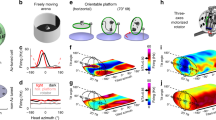Abstract
‘Place’ cells of the hippocampus and ‘head-direction’ (HD) cells of the thalamus and limbic cortex derive their spatial and directional specificity from a combination of idiothetic (self-motion) cues and external landmarks, which normally reinforce each other to generate a robust neural code for location and direction1. In weightlessness, however, three-dimensional navigation can cause the idiothetic and landmark cues to conflict. Nonetheless, neural recordings on the space shuttle demonstrated that the hippocampus can create a robust spatial code for three orthogonal surfaces in the weightless environment of space flight.
This is a preview of subscription content, access via your institution
Access options
Subscribe to this journal
Receive 12 print issues and online access
$209.00 per year
only $17.42 per issue
Buy this article
- Purchase on Springer Link
- Instant access to full article PDF
Prices may be subject to local taxes which are calculated during checkout



Similar content being viewed by others
References
Redish, A. D. Beyond the Cognitive Map (MIT Press, Cambridge, Massachusetts, 1999).
Knierim, J. J., Kudrimoti, H. S. & McNaughton, B. L. J. Neurosci. 15, 1648–1659 (1995).
O'Keefe, J. & Nadel, L. The Hippocampus as a Cognitive Map (Clarendon, Oxford, 1978).
Muller, R. U. & Kubie, J. L. J. Neurosci. 7, 1951–1968 (1987).
Goodridge, J. P., Dudchenko, P. A., Worboys, K. A., Golob, E. J. & Taube, J. S. Behav. Neurosci. 112, 749–761 (1998).
McNaughton, B. L. et al. J. Exp. Biol. 199, 173–185 (1996).
Jeffery, K. J. & O'Keefe, J. M. Exp. Brain Res. 127, 151–161 (1999).
Taube, J. S., Muller, R. U. & Ranck, J. B. Jr. J. Neurosci. 10, 420–435 (1990).
Taube, J. S. Prog. Neurobiol. 55, 225–256 (1998).
Oman, C. M. in Proceedings of the Symposium on Vestibular Organs and Altered Force Environment (eds. Igarashi, M. & Nute, K.) 25–37 (NASA Space Biomedical Research Institute, Houston, Texas, 1988).
Wilson, M.A. & McNaughton, B. L. Science 261, 1055–1058 (1993).
Gothard, K. M., Skaggs, W. E., Moore, K. M. & McNaughton, B. L. J. Neurosci. 16, 823–854 (1996).
Skaggs, W. E., McNaughton, B. L., Wilson, M. A. & Barnes, C. A. Hippocampus 6, 149–172 (1996).
McNaughton, B. L., Barnes, C. A. & O'Keefe, J. Exp. Brain Res. 52, 41–49 (1983).
Buzsaki, G. Brain Res. 398, 242–252 (1986).
Acknowledgements
We thank the crew of STS-90 (Scott Altman, Jay Buckey, Alex Dunlap, Kay Hire, Rick Linnehan, Chiaki Mukai, Jim Pawelczyk, Rick Searfoss and Dave Williams), Bryan Roberts, Lisa Baer, Mike Eodice, Laurie Dubrovin, Tom Howerton, Louis Ostrach, Chris Maese, Justine Grove, Ali Werner, Dave Bergner, Tom McCarthy, George Swaiss, Steve Carmen, Jim Cockrell and others at NASA-Ames. We also thank Casey Stengel (who designed and built the recording system), Krzystof Jagiello (who designed and wrote the data acquisition software), Kathy Dillon, Shanda Roberts, Shane Smith, Vince Pawlowski, Carol Barnes, Katalin Gothard, Veronica Fedor-Duys, Mark Bower, Karen Reinke, Chris Duffield, Luann Snyder, Doug Wellington and others at the University of Arizona. Additionally, we thank Bill Skaggs and Matt Wilson, who wrote much of the data analysis software, and science and engineering support and management teams at Johnson Space Center and Kennedy Space Center. Supported by grants NAG 2-949 from NASA; NS33471 and NS20331 from NIH; and N0014-98-1-0180 and N0014-96-1-1082 from ONR.
Author information
Authors and Affiliations
Corresponding author
Rights and permissions
About this article
Cite this article
Knierim, J., McNaughton, B. & Poe, G. Three-dimensional spatial selectivity of hippocampal neurons during space flight. Nat Neurosci 3, 209–210 (2000). https://doi.org/10.1038/72910
Received:
Accepted:
Issue Date:
DOI: https://doi.org/10.1038/72910
This article is cited by
-
Overexpression of catalase in mitochondria mitigates changes in hippocampal cytokine expression following simulated microgravity and isolation
npj Microgravity (2021)
-
100 bats and a long, dark tunnel: one neuroscientist’s quest to unlock the secrets of 3D navigation
Nature (2018)
-
Towards human exploration of space: the THESEUS review series on neurophysiology research priorities
npj Microgravity (2016)
-
Three-dimensional head-direction coding in the bat brain
Nature (2015)
-
Coming up: in search of the vertical dimension in the brain
Nature Neuroscience (2011)



